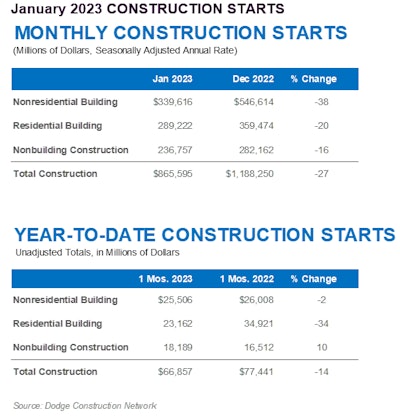
Total construction starts fell 27% in January to a seasonally adjusted annual rate of $865.6 billion, according to the Dodge Construction Network.
"It was not a great month for construction starts, at least when you look at it in these aggregate terms," said Richard Branch, chief economist for Dodge Construction Network.
By the numbers, he said, nonresidential building starts fell 38%; residential starts lost 20%, and nonbuilding starts declined by 16%.
Regionally, total construction starts in January fell in all five regions.
Comparatively, total construction was 14% lower in January 2023 than in January 2022. Nonresidential building starts were down 2%, nonbuilding starts rose 10%, and residential starts lost 34%.
For the 12 months ending January 2023, total construction starts were 13% higher than the 12 months ending January 2022. Nonresidential starts rose 36%, residential starts lost 6%, and nonbuilding starts were up 19%.
Branch emphasized that "one month does not a trend make."
“I think that the January decline in construction starts should not be taken as the beginning of a cyclical downturn in the construction sector,” he said, citing the great number of mega projects exceeding $500 million to $750 million or over a $1 billion that have broken ground over the last few months and obscured the underlying trend in construction activity.
“While some construction sectors will face stress as the year progresses, current fundamentals point to an industry that is well positioned to weather the storm,” Branch said.

Nonbuilding construction
The Dodge report indicates that nonbuilding construction starts fell 16% in January to a seasonally adjusted annual rate of $237 billion.
Behind the decline was a very large drop (-76%) in utility/gas plant starts following a brisk December. Elsewhere, environmental public works starts rose by 22%, miscellaneous nonbuilding increased by 17%, and highway and bridge starts rose by 1%.
For the full year, total nonbuilding starts were 18% higher than in 2021. The report states that the utility/gas plant starts rose 28%, and highway bridge starts were 20% higher. Environmental public works starts and miscellaneous nonbuilding starts were up 17% and 5% respectively year-over-year.
The largest nonbuilding projects to break ground in January were the $750 million High Banks wind farm in Belleville, Kansas, the $570 million first phase of Highway 69 express toll lanes in Overland Park, Kansas, and the $492 million CEPP/EAA reservoir in Palm Beach, Florida.
Nonresidential building
According to the report, nonresidential building fared no better, with total starts losing 38% in January to a seasonally adjusted annual rate of $340 billion.
Manufacturing starts led the pullback in January, falling 91% following the start of several large projects in December. In addition, commercial starts dropped 11% with office being the only category to post a gain; while institutional starts increased by 3% thanks to a large gain in education starts.
For the full year, nonresidential building starts were 36% higher than in 2021, with manufacturing starts leading all gains at 190% higher. Further year-over-year analysis showed commercial starts gaining 22% and institutional starts were up by 17% on a 12-month rolling sum basis.
The largest nonresidential building projects to break ground in January were the $1 billion Prime Data Center campus in Elk Grove Village, Illinois, the $515 million Amazon data center in Hilliard, Ohio, and the $460 million CoStar Group corporate campus in Richmond, Virginia.
Residential building
January saw most levels of construction dip, including residential starts, which were down 20% for the month to a seasonally adjusted annual rate of $289.2 billion.
The report states that single-family starts lost 5%, and multifamily starts fell 37%.
Overall, residential starts were 5% lower in a year-over-year analysis. Dodge analysts stated that single-family starts were 16% lower, while multifamily starts were up 21% on a rolling 12-month basis.
The largest multifamily structures to break ground in January were a $200 million mixed-use building in Gowanus, New York, a $172 million mixed-use building in Greenpoint, New York, and the $150 million The Cove residential community in Sacramento, California.











